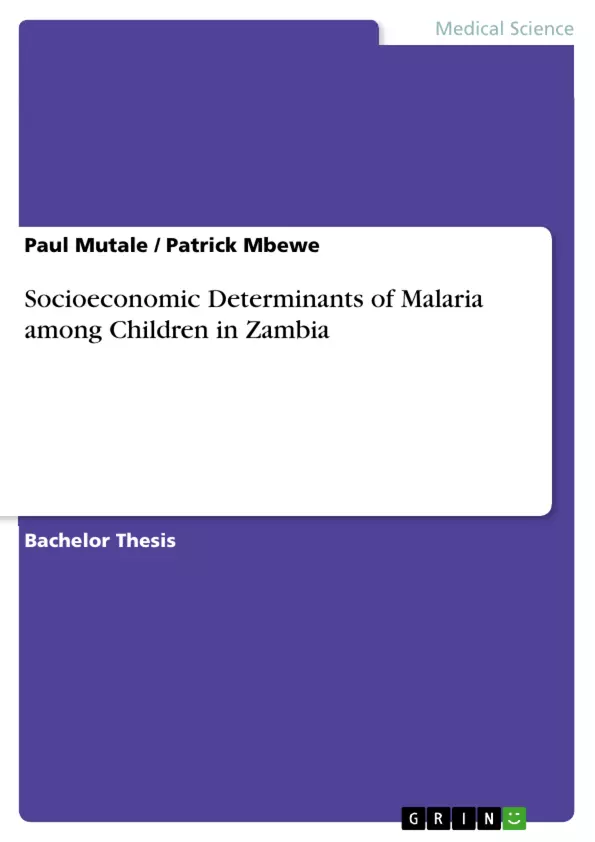There are wide gaps in empirical information on socioeconomic determinants of malaria among children under five. The main objective of this study was to investigate the socioeconomic factors such as mother’s education level, wealth of household, age of child, employment status and gender of child among other variables to establish how they influence malaria in children under five years of age.
Initially a proportional cross-sectional analysis was conducted using the 2013/14 Zambia demographic health survey report (ZDHS) data. The results of proportion of children who had malaria by their socioeconomic characteristics were highest among children aged 12-23 months with malaria of 27.1 percent prevalence levels while across child gender about 20.4 percent males and 21.6 percent females had malaria. In relation to mothers education highest proportions were observed among mothers with no education representing 24 percent with lowest 15percent for those with more than secondary school level of education. In terms of wealth the highest proportion was observed from second and lowest wealth quartile with 23.6 and 22.7 percent respectively while the lowest 17.6 percent was observed from those in the highest or richest level of wealth.
Then a probit regression analysis was done among selected socioeconomic factors and marginal effects where computed and presented in table 5, the probit regression show that a total of 9722 observations were analyzed and that if the average age of a child in months goes up by one unit, the probability of a child having malaria reduces by 0.078%. In terms of education mothers who have had no education increases the probability of a child having malaria by 3.22% holding other variable constant. This is a clear indication of the influences of socio economic factors on prevalence of malaria in children under five.
Inhaltsverzeichnis (Table of Contents)
- ABSTRACT
- Acknowledgement
- Abbreviations
- 1.0.0 INTRODUCTION
- 1.1.0 Background
- 1.2.0 Problem Statement
- 1.3.0 Justification
- 1.4.0 GENERAL OBJECTIVES
- 1.5.0 Specific Objective
- 1.6.0 Research Question
- 1.7.0 Hypotheses Statements
- 1.8.0 Scope of Study
- 1.9.0 Limitation
- 2.0.0 Literature review
- 2.1.0 Malaria in Zambia
- 2.2.0 Malaria transmission and illness
- 2.3.0 Factors associated with malaria illness
- 2.4.0 Conceptual Framework
- 3.0.0 Methodology
- 3.1.0 Sample design
- 3.2 Variable definition; table 2
- 3.3.0 Model estimation Technique
- 3.4.0 Justification for choice of probit model
- 4.0.0 FINDINGS
- 4.1.0 Introduction
- 4.2.0 Data presentation
- 4.2.1 Proportional presentation of malaria distribution across selected factors
- 4.3.0 Summary of Diagnostic Test
- 4.4.0 Probit Regression Model With Robust Standard Errors
- 4.5.0 Marginal effects of probit analysis
- 4.5.1 The extent of socioeconomic factors influence on malaria
Zielsetzung und Themenschwerpunkte (Objectives and Key Themes)
This study aimed to investigate the socioeconomic factors that influence malaria incidences among children under five years of age in Zambia. The study employed a cross-sectional analysis and a probit regression model to analyze data from the 2013/14 Zambia Demographic Health Survey (ZDHS).
- Socioeconomic determinants of malaria in children under five in Zambia
- The influence of mother's education level on malaria incidence
- The relationship between household wealth and malaria prevalence
- The role of child's age and gender in malaria susceptibility
- The application of probit regression analysis to assess the impact of socioeconomic factors on malaria incidence
Zusammenfassung der Kapitel (Chapter Summaries)
The report begins with an introduction that outlines the background, problem statement, justification, objectives, research questions, hypotheses, scope, and limitations of the study. Chapter two presents a literature review on malaria in Zambia, its transmission and illness, and factors associated with malaria illness. It also includes a conceptual framework. Chapter three describes the methodology, including sample design, variable definitions, model estimation technique, and justification for the choice of probit model. Chapter four presents the findings of the study, including data presentation, summary of diagnostic tests, results of probit regression model with robust standard errors, and marginal effects of the probit analysis. The chapter concludes by discussing the extent of socioeconomic factors' influence on malaria in children under five.
Schlüsselwörter (Keywords)
Malaria, socioeconomic determinants, children under five, Zambia, ZDHS, probit regression, mother's education, household wealth, child's age, child's gender, prevalence.
- Citar trabajo
- Paul Mutale (Autor), Patrick Mbewe (Autor), 2017, Socioeconomic Determinants of Malaria among Children in Zambia, Múnich, GRIN Verlag, https://www.grin.com/document/517311



